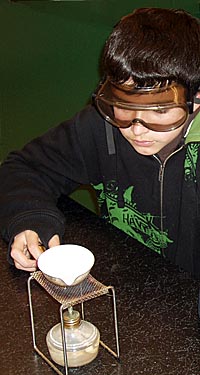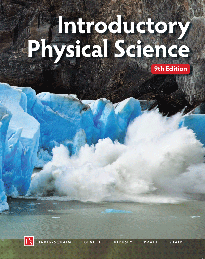The Meaning of "Inquiry"
Is It Inquiry-Based?
 What is meant by "inquiry-based" or "inquiry-oriented" instructional materials? What criteria can you use as you examine instructional materials to determine if they are truly inquiry-oriented? The term is widely used and often over-used, so it needs a closer examination.
What is meant by "inquiry-based" or "inquiry-oriented" instructional materials? What criteria can you use as you examine instructional materials to determine if they are truly inquiry-oriented? The term is widely used and often over-used, so it needs a closer examination.
One of the best resources on the meaning of inquiry is the National Science Education Standards (NSES) (NRC, 1996) developed and published by the National Academy of Sciences—an organization of the nation’s most outstanding and recognized scientists. The NSES defines inquiry as follows:
Inquiry is a multifaceted activity that involves making observations; posing questions; examining books and other sources of information to see what is already known; planning investigations; reviewing what is known in light of experimental evidence; using tools to gather, analyze, and interpret data; proposing answers, explanations, and predictions; and communicating results. Inquiry requires identifications of assumptions, use of critical and logical thinking, and consideration of alternative explanations. (NSES, page 23)
There are many things to notice in this definition but an important one is that inquiry is not a simple, narrow and straightforward process. It doesn’t sound like the five step scientific method so often seen on classroom walls. Nevertheless, the authors of the NSES felt that the use of inquiry in the science classroom was so important that they created a companion document (sometimes referred to as an addendum to the standards), Inquiry and the National Science Education Standards: A Guide for Teaching and Learning (NRC, 2000).* The addendum outlined the following five essential features of classroom inquiry to help us understand what inquiry in a science classroom should look like.
- Learners are engaged by scientifically oriented questions.
- Learners give priority to evidence in responding to questions.
- Learners formulate explanations from evidence.
- Learners evaluate their explanations in light of alternative explanations, particularly those reflecting scientific knowledge.
- Learners communicate and justify their proposed explanations.
Notice the emphasis on the learner taking the action. One of characteristics of instructional materials that claim to be inquiry-based is that they place much of the responsibility for the work and thinking on the student. The five features are not “steps” to be followed; they are criteria to help teachers and writers determine if instructional materials and teaching strategies are inquiry-based.
We think it useful to apply the essential features of inquiry to the SCI products, Introductory Physical Science (IPS) and Force Motion and Energy (FM&E) to see how they measure up. The following table refers to the essential features by number in the first column. The approach used in IPS and FM&E and an example from IPS appear in the remaining columns.
Essential |
A description of the approach |
An example from IPS: |
1 |
The text raises a question usually related to the work or reading completed in the previous section. |
“How are solubilities of different substances affected by the temperature of the liquid?” |
2 |
General directions are provided in the text, but the student is expected to design the details of the experiment. In the pre-lab discussion, the teacher helps students make connections among the question, the laboratory procedure, and the data that will be collected. |
“To find out if the solubilities of different substances are affected by temperature, add 10 g of two solids to two test tubes, each of which contains 10 cm3 of water. Place both test tubes in a large beaker of water, and stir the solutions for several minutes until they are saturated. Now heat the beaker, stirring both solutions constantly, until the water in the beaker is near boiling.” |
3 |
Bulleted questions assist the student in developing explanations that provide possible answers to the opening question. |
|
4 |
The text and Teacher’s Guide and Resource Book provide sample data that the teacher and students can compare to their experimental results. The understanding used in explaining lab results is further evaluated and expanded by asking students to review graphs and/or answer a few end-of-section problems. |
The text provides a graph of the solubility of potassium sulfate, another substance having similar solubility properties to the substances used in the experiment. |
5 |
Student participation and discourse is an ongoing part of the course. Students are often asked to justify the physical set-up and procedure they propose for the experiment. In the post-lab discussion, they present and justify their data and explanations, first in their small lab team and then to the class. |
In virtually all of the experiments, including this one, data are shared and conclusions drawn from the merged and accumulated data. |
The five essential features of classroom inquiry stipulated in Inquiry and the National Science Education Standards apply to the evaluation of both classroom practice and textbook evaluation. Applying those criteria, the above analysis seems to clearly support the approach taken in IPS and FM&E as being inquiry-oriented. As such, they help students develop laboratory skills, thinking skills, and an understanding of the way science works. More importantly, they provide opportunities for students to realize that true understanding of the ideas of science comes only from an understanding of the evidence supporting those ideas. Without evidence, students are forced to rely on someone else's interpretation; they do not participate in creating their own understanding.
*The addendum can be read in its entirety or ordered at www.nap.edu. The author of this article, Harold Pratt, contributed to the writing of the addendum as a member of the staff of the National Research Council.
References:
National Research Council. (1996). The National Science Education Standards. Washington, DC: The National Academy Press.
National Research Council. (2000). Inquiry and the National Science Education Standards: A Guide to Teaching and Learning. Washington, DC: The National Academy Press.
Available: Now

The new 9th Edition of Introductory Physical Science (IPS) continues the IPS tradition of guiding students to knowledge of physical science and the way scientific knowledge is acquired.
Inspect the table of contents and more details on our new edition of IPS.
